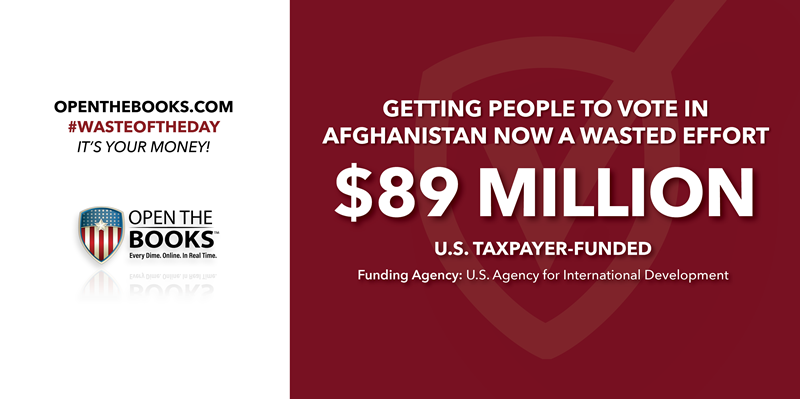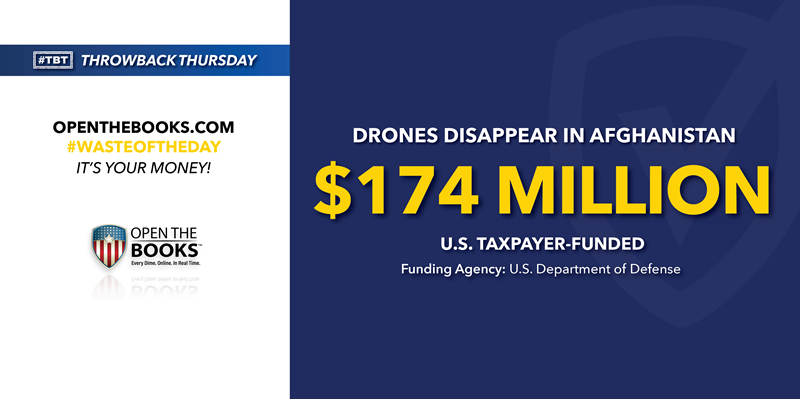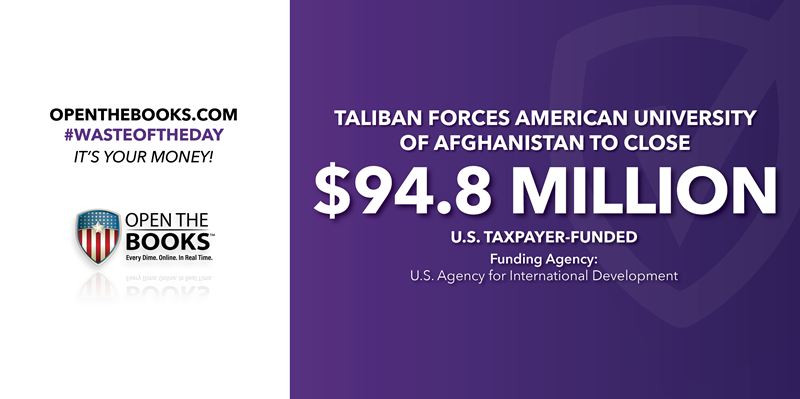
Failure: U.S. Spent $800 Million to Encourage the Taliban & Others to Respect Women | August 23, 2021

The world watched last week as the Taliban took over the Afghan capital of Kabul, the last piece the terrorist group needed for total domination of the country.
After almost 20 years in Afghanistan, American troops withdrew swiftly under the orders of President Joe Biden, leaving the country wide open to be swept up the Taliban.
The U.S. spent approximate $2.3 trillion in Afghanistan over those two decades. Included in that total was an attempt to help women get a leg up in a place that treats them as second-class citizens.
At least $800 million – and probably billions more indirectly though other programming -- has been spent on various efforts to elevate women, whether it be to strengthen their participation in civil society or avoid falling victim to gender-based violence.
A Jan. 30, 2021 quarterly report by Special Inspector General for Afghanistan Reconstruction to Congress documented some of the programs. Expenditures included $27 million on a program called “Promote: Women’s Rights Groups and Coalition”; $6.7 million to fight “Gender Based Violence”; and $7.4 million on “Promote: Rolling Baseline and End-Line Survey,” a study to determine results of a program to promote gender equity.
A program called Musharikat said it recruited more 7,000 women-focused advocates to its network.
Among some of the popular discussion prompts on Musharikat’s member website last year related to the ongoing peace process were:
- Do you think the Taliban will change their mentality, ambition and behavior of 1990s and play an equal role in ensuring social justice?
- What are your specific opinions about women’s situation after a potential agreement with the Taliban?
In light of the Taliban’s recent takeover and the first female mayor in Afghanistan fearing for her life, it’s a joke to think any amount of money spent on training women would win over the Taliban.
Learn more:
OpenTheBooks Oversight Report, U.S. Foreign Aid
Forbes, 10 U.S. Investments In Afghanistan That Didn’t Pan Out
$89 Million in U.S. Funding to Increase Election Participation in Afghanistan | August 24, 2021

As the Taliban took over the Afghan capital city of Kabul, President Ashraf Ghani fled — with cars full of cash.
That’s as thousands of residents tried, mostly unsuccessfully, to flee the country now run by the Taliban after American troops pulled out under President Joe Biden’s orders.
A single U.S. Air Force C-17A cargo jet carried 800 Afghans fleeing in terror while at least seven people died at the airport in Kabul, including some who grabbed onto the outside of the plane as it flew away.
During the United States’ almost 20 years in the country, spending $2.3 trillion, at least $89 million from U.S. Agency for International Development was spent to increase election participation in Afghanistan.
The goal was a democratic government with broad citizen participation.
Ghani had been president since September 2014 until he fled the country, leaving his constituents behind.
With the United States’ help to elevate women, the country saw its first female mayor elected to govern Maidan Sharh in central Afghanistan in 2018. Not only was she the first woman but she is believed to have been the youngest. Zarifa Ghafari, now 27, believes the Taliban will kill her.
Increasing election participation in Afghanistan was a noble goal. With the swift U.S. withdrawal and Islamic fundamentalist takeover, the U.S. objective has been laid to waste.
Learn more:
OpenTheBooks Oversight Report, U.S. Foreign Aid
Forbes, 10 U.S. Investments In Afghanistan That Didn’t Pan Out
No Magic Carpet Will Rescue Vendors in Afghanistan – Despite U.S. Investment of $9.4 Million | August 25, 2021

In 2018, the U.S. Agency for International Development began pumping $9.4 million into establishing a Kabul carpet export center.
Noting the importance of the Afghan carpet industry — Afghanistan’s second largest employer after agriculture — USAID created the center “to enhance the capacity of the Afghan carpet industry to meet international market requirements by addressing major constraints in the process of bringing carpets to market.”
The export center helped the carpet industry employ women, young people, returning refugees, and internally displaced Afghans with carpet-making skills, USAID said.
The export center described itself as “a team of passionate professionals whose goal is to help international buyers of hand-made carpets develop long-term relationships with Afghan carpet manufacturers while creating both fine carpets and jobs for skilled weavers and craftsmen.”
The Taliban has since taken over the country, laying claim to the capital city of Kabul.
A Manhattan rug bazaar in May displayed colorful weaves as Afghan merchants wondered about the future of their country and their industry.
Three months later, the export center and its website have both been shut down amid the chaotic takeover. But its Instagram and Facebook accounts remain for now, an homage to a once colorful market employing hard-working Afghans, a carpet mecca kicked off with American money.
Learn more:
OpenTheBooks Oversight Report, U.S. Foreign Aid
Forbes, 10 U.S. Investments In Afghanistan That Didn’t Pan Out
U.S. Drones Worth $174 Million Were “Lost” in Afghanistan | August 26, 2021

Throwback Thursday!
As the U.S. military continues to clear out of Afghanistan and residents flee since the Taliban's takeover, it’s worth looking back at how American funds to aid operations in Afghanistan were wasted over almost 20 years.
Desperate to escape the Taliban and get on recent evacuation flights, seven people died at Kabul airport, including some who grabbed onto the outside of a U.S. Air Force C-17A cargo jet carrying 800 Afghans fleeing in terror.
The sad scene is at once unexpected and shocking. And it shows the desperation as American troops withdraw after two decades.
During that time, taxpayer money has been used in nation-building missions since removing the Taliban from power, some of which turned out to be a complete waste of money.
In his 2020 “Festivus Report,” a reference to the made-up holiday from “Seinfeld,” Sen. Rand Paul noted that the Department of Defense spent $174 million on drones that were lost in Afghanistan.
The drones were to be part of the attempt to help the Afghan National Army defend itself. But the ANA didn’t immediately use the drones and the DoD, along with its contractor, lost track of the drones.
The drone loss is just one of many examples over the 20 years of bungling in Afghanistan that cost American lives and money.
Learn more:
OpenTheBooks Oversight Report, U.S. Foreign Aid
Forbes, 10 U.S. Investments In Afghanistan That Didn’t Pan Out
American University of Afghanistan Closed Up As Taliban Takes Over
| August 27, 2021

The “life changing” American University of Afghanistan opened its doors in 2006 but was captured by the Taliban as it took over the country, and finally the capital city of Kabul, last week.
The world watched as 20 years of progress and rights for women and members of minority groups were rolled back.
The American University of Afghanistan, the country’s first private, not-for-profit institution of higher education, gave out undergraduate, graduate and professional degrees.
It was established with a $94.8 million grant from U.S. Agency for International Development.
In 2010, when the university hired a new president, Akram Fazel, chairman of the university’s Board of Trustees, said, “When you go back to the history of Afghanistan and analyze what really went wrong, for almost 300 years, it was totally isolated from the rest of world. We hope this institution becomes a bridging factor to the outside world.”
And it was for some time. It started with about 50 students and ballooned to around 1,700, producing 29 Fulbright Scholars and partnering with prestigious universities, including Stanford University, University of Chicago Pearson Institute, University of Maryland, Georgetown University, and the University of California.
But with the Taliban takeover, the university’s entire internet presence appears to have been wiped out, including its website, Twitter, and Facebook pages.
Days before the Afghan government collapsed, Leslie Schweitzer, a member of AUAF’s Board of Trustees and president of the Washington, D.C.-based nonprofit organization Friends of the American University of Afghanistan, said the university was trying to set up partnerships with other universities in the region so students could study remotely, Inside Higher Ed reported.
It’s unclear how far that effort got before Kabul, and with it the university, fell into Taliban hands.
Learn more:
OpenTheBooks Oversight Report, U.S. Foreign Aid
Forbes, 10 U.S. Investments In Afghanistan That Didn’t Pan Out
The #WasteOfTheDay is presented by the forensic auditors at OpenTheBooks.com.